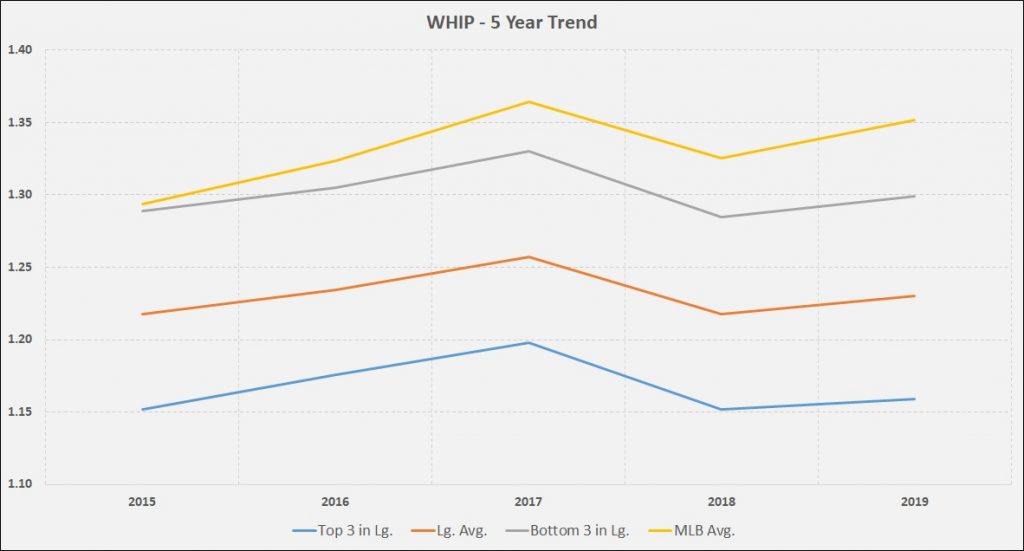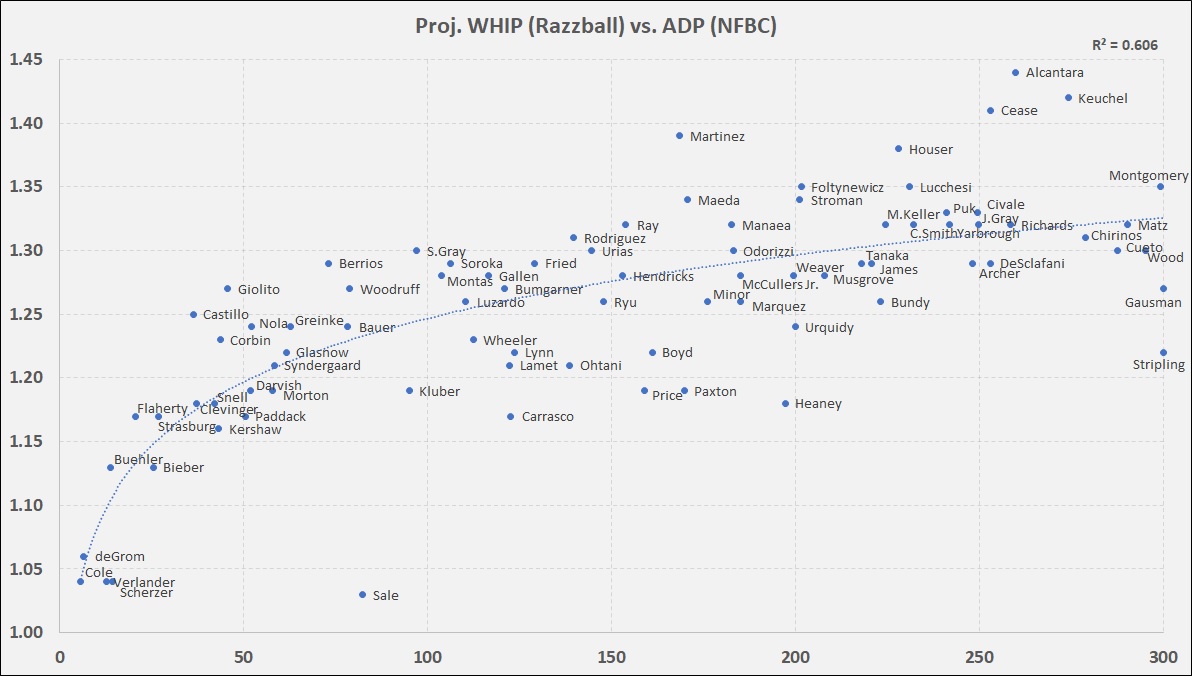Last week, I introduced the goal of this series: utilizing data visualization to try and narrow in on fantasy baseball insights. We looked at ERA across the draft, finding some potential values based on ADP. Today, we’ll take a closer look at Starting Pitcher WHIP by ADP.
To begin with, what’s the context in which we should gauge whether an SP’s WHIP actually helps our team? Here are WHIP trends over the last 5 years:

The last two years have shown relative steadiness. Unlike ERA, which spiked last year, we see only a slight uptick in WHIP. That makes sense with the ball being juiced: it’s not that pitchers are giving up more baserunners, but that each ball hit is more likely to become a HR. That hurts ERA a lot more than WHIP.
Looking towards 2020, this should make WHIP a relatively safe investment. Whether the ball is de-juiced or not shouldn’t dramatically impact the rate of balls landing for hits. In four of the last five years, you need a team WHIP below 1.175 to land in the top 3, and anything above 1.23 will land you in the bottom half. So, who can help our teams achieve this? The chart below plots Razzball (Steamer/Rudy) projected WHIP for SP (>99IP) vs. NFBC ADP:
I’ll give the same two caveats: 1) OF COURSE you should look at other data (age, velocity, K-rate, IP), and 2) projecting WHIP is very hard (slightly easier than projecting ERA, but hard).
To start with: only 20 pitchers are projected under 1.20. Does that sound realistic? It shouldn’t! Last year, there were 36 SP with 100+ IP and a WHIP at 1.20 or less. 54(!) in 2018, 31 in 2017. and 43 in 2016.
What’s going on?
Simply put, projections are built to optimize for most players. The best way to do that? Regression – expecting that most players will pitch at the level most players historically have. It takes a significant sample size before projections will assume an individual pitcher’s talent is above average.
The answer isn’t to throw out projections, it’s to look at projections in relation to the projected player universe, not to past seasons. We care about the relative WHIP of these pitchers. The trendline helps us find the relative value of pitchers at all points in the draft. (This explains the lowest projected WHIP as 1.03, despite every year a handful of individual pitchers going below 1.00, and the top guy below 0.90).
Enough context. Let’s get to the ADP Bargains:
- Corey Kluber: Until last year’s injury-ravaged season, Kluber had a WHIP below 1.10 for five straight season. This one is all about health.
- David Price: AL to NL? Check. Dodger Stadium for home games? Check. Healthy in ST? Check. Ability to avoid a likely blowup spot (@Col)? Check. He’s unlikely to throw 180 IP but I trust the Dodgers to manage his health. 160 IP of sub-1.20 WHIP looks awfully attractive at his price point.
- Carlos Carrasco: Another injury-related discount. We don’t know how his battle with leukemia will impact IP, but the quality should be there. Recent elbow soreness as a second red flag would push me off of him.
- Andrew Heaney: Projections really love Heaney this year; he’s (by far) the latest-drafted SP projected for sub-1.20 WHIP. He achieved it in 2018 so it’s not unprecedented.
- Matthew Boyd: 1.16 and 1.23 the last two years, over a lot of innings. Wins will be tough to come by, and a low-to-mid 4.00s ERA wouldn’t surprise, but this high-K, low-WHIP profile is exactly the type who could easily breakout beyond results so far.
- Jose Urquidy: One of my favorite mid-to-later round dart throws. Appealing profile, should earn wins, and locked up a rotation spot. I would expect the price to rise over the next few weeks.
- Kevin Gausman: Hard to overstate just how much of a boost he should get going from AL East and home games in Camden, to NL and San Francisco. Still only 28. One of my favorite late round targets.
- Ross Stripling: Strong performance regardless of role, but caution. In a standard mixed league, you can’t hold non-closing non-starters for long, hoping to get a rotation spot. Keep his name in mind and be quick on the free agent trigger during the year when the Dodgers play IL games.
On the other side of the line, we find the SP projected to hurt your WHIP at cost:
- Luis Castillo: You can go broke trying to guess exactly where projections are wrong, but this one looks off. In 3 seasons spanning 450IP, his career WHIP is 1.16, including 1.14 last year.
- Lucas Giolito: As mentioned last week when looking at ERA, projections DO NOT buy the breakout. Yeah, the 1.48 WHIP From 2018 looks scary, but this is a completely different pitcher, coming off 176 innings of 1.06 WHIP ball. I’ll take the under.
- Jose Berrios: Another one that raises an eyebrow. In 3 full seasons, Berrios’ highest WHIP was 1.23. Still only 26 years old. It’s fair to say he likely won’t help you win the category.
- Sonny Gray: He’s yo-yo’d around the last 5 years (1.08, 1.50, 1.21, 1.50, 1.08). Coming off a good season, projections put him right in the middle.
- Carlos Martinez: Even when he was a strong SP, his WHIPs never helped you. 1.38 looks high. But with role concerns and potential for injury-limited workload, I can see passing.
- Adrian Houser: Buzzy name rising up draft boards the last few weeks. Projections see a history of mediocre-to-bad WHIPs and project more of the same.
- Dylan Cease, Sandy Alcantara, and Dallas Keuchel: Plenty of late pitchers to target who aren’t likely to destroy your ratios.



